check engine YAMAHA TDM 900 2009 Owners Manual
[x] Cancel search | Manufacturer: YAMAHA, Model Year: 2009, Model line: TDM 900, Model: YAMAHA TDM 900 2009Pages: 94, PDF Size: 3.75 MB
Page 6 of 94
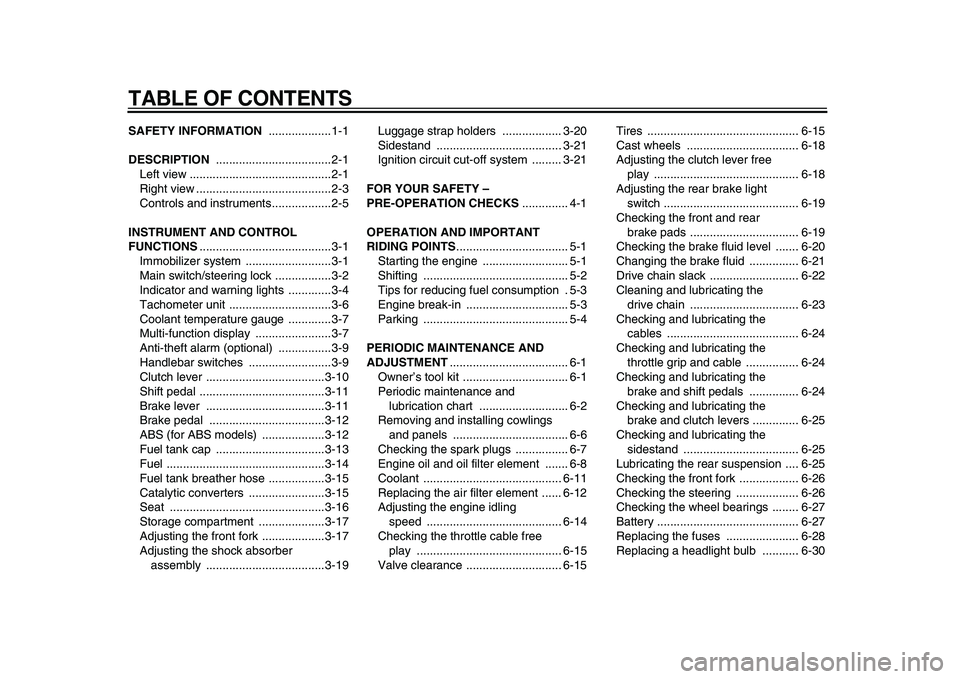
TABLE OF CONTENTS
SAFETY INFORMATION
...................1-1
DESCRIPTION
...................................2-1
Left view ...........................................2-1
Right view .........................................2-3
Controls and instruments..................2-5
INSTRUMENT AND CONTROL
FUNCTIONS
........................................3-1
Immobilizer system ..........................3-1
Main switch/steering lock .................3-2
Indicator and warning lights .............3-4
Tachometer unit ...............................3-6
Coolant temperature gauge .............3-7
Multi-function display .......................3-7
Anti-theft alarm (optional) ................3-9
Handlebar switches .........................3-9
Clutch lever ....................................3-10
Shift pedal ......................................3-11
Brake lever ....................................3-11
Brake pedal ...................................3-12
ABS (for ABS models) ...................3-12
Fuel tank cap .................................3-13
Fuel ................................................3-14
Fuel tank breather hose .................3-15
Catalytic converters .......................3-15
Seat ...............................................3-16
Storage compartment ....................3-17
Adjusting the front fork ...................3-17
Adjusting the shock absorber
assembly ....................................3-19Luggage strap holders .................. 3-20
Sidestand ...................................... 3-21
Ignition circuit cut-off system ......... 3-21
FOR YOUR SAFETY –
PRE-OPERATION CHECKS
.............. 4-1
OPERATION AND IMPORTANT
RIDING POINTS
.................................. 5-1
Starting the engine .......................... 5-1
Shifting ............................................ 5-2
Tips for reducing fuel consumption . 5-3
Engine break-in ............................... 5-3
Parking ............................................ 5-4
PERIODIC MAINTENANCE AND
ADJUSTMENT
.................................... 6-1
Owner’s tool kit ................................ 6-1
Periodic maintenance and
lubrication chart ........................... 6-2
Removing and installing cowlings
and panels ................................... 6-6
Checking the spark plugs ................ 6-7
Engine oil and oil filter element ....... 6-8
Coolant .......................................... 6-11
Replacing the air filter element ...... 6-12
Adjusting the engine idling
speed ......................................... 6-14
Checking the throttle cable free
play ............................................ 6-15
Valve clearance ............................. 6-15Tires .............................................. 6-15
Cast wheels .................................. 6-18
Adjusting the clutch lever free
play ............................................ 6-18
Adjusting the rear brake light
switch ......................................... 6-19
Checking the front and rear
brake pads ................................. 6-19
Checking the brake fluid level ....... 6-20
Changing the brake fluid ............... 6-21
Drive chain slack ........................... 6-22
Cleaning and lubricating the
drive chain ................................. 6-23
Checking and lubricating the
cables ........................................ 6-24
Checking and lubricating the
throttle grip and cable ................ 6-24
Checking and lubricating the
brake and shift pedals ............... 6-24
Checking and lubricating the
brake and clutch levers .............. 6-25
Checking and lubricating the
sidestand ................................... 6-25
Lubricating the rear suspension .... 6-25
Checking the front fork .................. 6-26
Checking the steering ................... 6-26
Checking the wheel bearings ........ 6-27
Battery ........................................... 6-27
Replacing the fuses ...................... 6-28
Replacing a headlight bulb ........... 6-30
Page 10 of 94
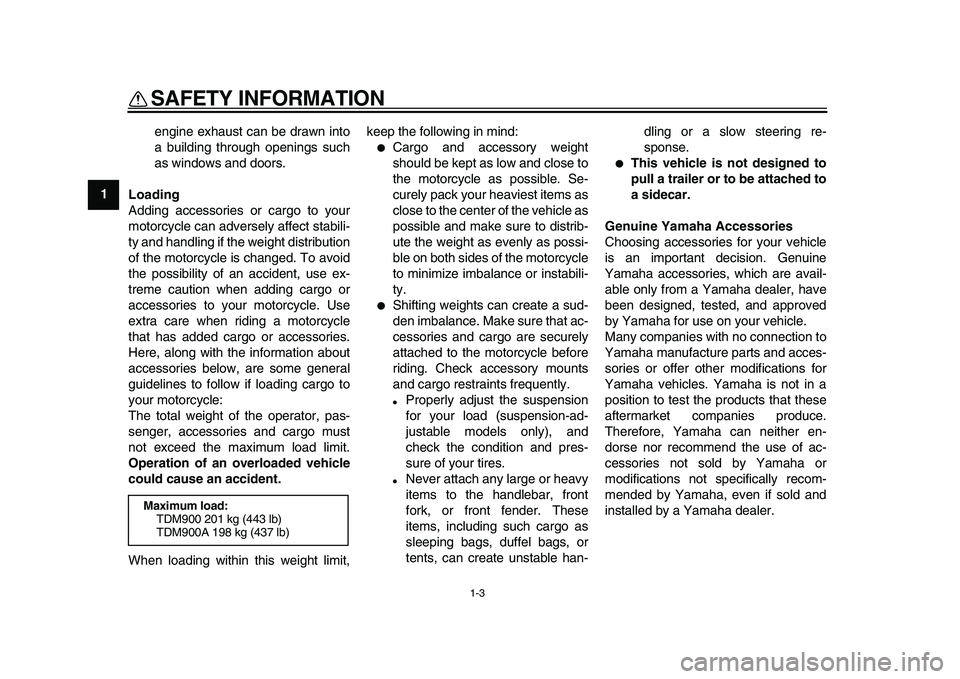
SAFETY INFORMATION
1-3
1
engine exhaust can be drawn into
a building through openings such
as windows and doors.
Loading
Adding accessories or cargo to your
motorcycle can adversely affect stabili-
ty and handling if the weight distribution
of the motorcycle is changed. To avoid
the possibility of an accident, use ex-
treme caution when adding cargo or
accessories to your motorcycle. Use
extra care when riding a motorcycle
that has added cargo or accessories.
Here, along with the information about
accessories below, are some general
guidelines to follow if loading cargo to
your motorcycle:
The total weight of the operator, pas-
senger, accessories and cargo must
not exceed the maximum load limit.
Operation of an overloaded vehicle
could cause an accident.
When loading within this weight limit,keep the following in mind:
●
Cargo and accessory weight
should be kept as low and close to
the motorcycle as possible. Se-
curely pack your heaviest items as
close to the center of the vehicle as
possible and make sure to distrib-
ute the weight as evenly as possi-
ble on both sides of the motorcycle
to minimize imbalance or instabili-
ty.
●
Shifting weights can create a sud-
den imbalance. Make sure that ac-
cessories and cargo are securely
attached to the motorcycle before
riding. Check accessory mounts
and cargo restraints frequently.
●
Properly adjust the suspension
for your load (suspension-ad-
justable models only), and
check the condition and pres-
sure of your tires.
●
Never attach any large or heavy
items to the handlebar, front
fork, or front fender. These
items, including such cargo as
sleeping bags, duffel bags, or
tents, can create unstable han-dling or a slow steering re-
sponse.
●
This vehicle is not designed to
pull a trailer or to be attached to
a sidecar.
Genuine Yamaha Accessories
Choosing accessories for your vehicle
is an important decision. Genuine
Yamaha accessories, which are avail-
able only from a Yamaha dealer, have
been designed, tested, and approved
by Yamaha for use on your vehicle.
Many companies with no connection to
Yamaha manufacture parts and acces-
sories or offer other modifications for
Yamaha vehicles. Yamaha is not in a
position to test the products that these
aftermarket companies produce.
Therefore, Yamaha can neither en-
dorse nor recommend the use of ac-
cessories not sold by Yamaha or
modifications not specifically recom-
mended by Yamaha, even if sold and
installed by a Yamaha dealer.
Maximum load:
TDM900 201 kg (443 lb)
TDM900A 198 kg (437 lb)
Page 20 of 94
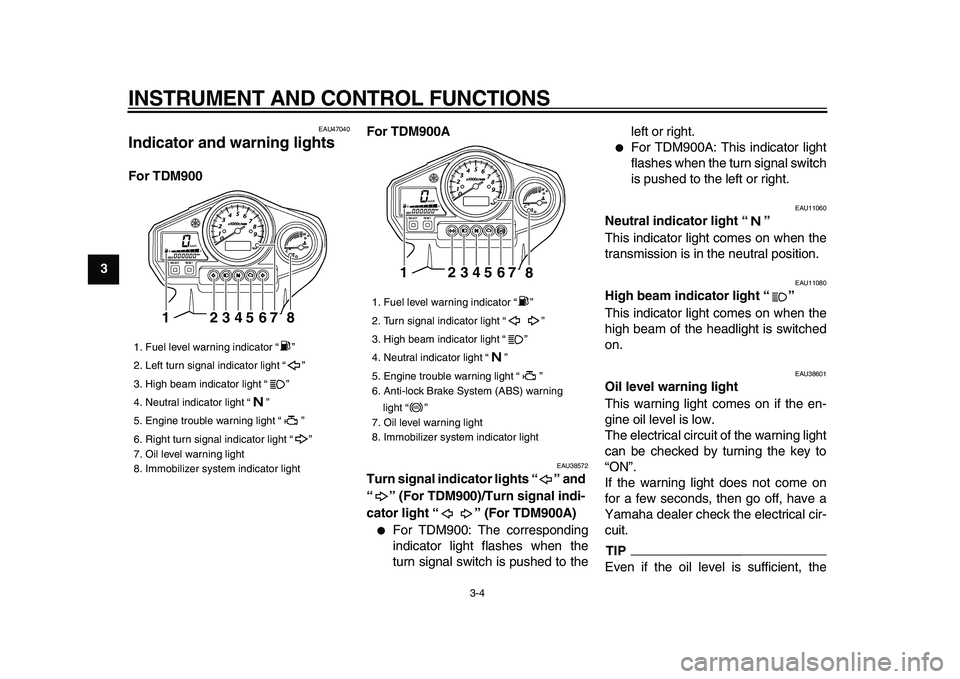
INSTRUMENT AND CONTROL FUNCTIONS
3-4
1
2
3
4
5
6
7
8
9
EAU47040
Indicator and warning lights
For TDM900For TDM900A
EAU38572
Turn signal indicator lights “ ” and
“” (For TDM900)/Turn signal indi-
cator light “ ” (For TDM900A)
●
For TDM900: The corresponding
indicator light flashes when the
turn signal switch is pushed to theleft or right.
●
For TDM900A: This indicator light
flashes when the turn signal switch
is pushed to the left or right.
EAU11060
Neutral indicator light “ ”
This indicator light comes on when the
transmission is in the neutral position.
EAU11080
High beam indicator light “ ”
This indicator light comes on when the
high beam of the headlight is switched
on.
EAU38601
Oil level warning light
This warning light comes on if the en-
gine oil level is low.
The electrical circuit of the warning light
can be checked by turning the key to
“ON”.
If the warning light does not come on
for a few seconds, then go off, have a
Yamaha dealer check the electrical cir-
cuit.
TIP
Even if the oil level is sufficient, the
1. Fuel level warning indicator “ ”
2. Left turn signal indicator light “ ”
3. High beam indicator light “ ”
4. Neutral indicator light “ ”
5. Engine trouble warning light “ ”
6. Right turn signal indicator light “ ”
7. Oil level warning light
8. Immobilizer system indicator light
12345678
1. Fuel level warning indicator “ ”
2. Turn signal indicator light “ ”
3. High beam indicator light “ ”
4. Neutral indicator light “ ”
5. Engine trouble warning light “ ”
6. Anti-lock Brake System (ABS) warning
light “ ”
7. Oil level warning light
8. Immobilizer system indicator light
1234567
8
ABS
Page 21 of 94

INSTRUMENT AND CONTROL FUNCTIONS
3-5
2
34
5
6
7
8
9
warning light may flicker when riding on
a slope or during sudden acceleration
or deceleration, but this is not a mal-
function.
EAU11371
Fuel level warning indicator “ ”
This fuel level warning indicator starts
flashing when the fuel level drops be-
low approximately 3.5 L (0.92 US gal,
0.77 Imp.gal).
EAU11503
Engine trouble warning light “ ”
This warning light comes on or flashes
if a problem is detected in the electrical
circuit monitoring the engine. If this oc-
curs, have a Yamaha dealer check the
self-diagnosis system. (See page 3-7
for an explanation of the self-diagnosis
device.)
The electrical circuit of the warning light
can be checked by turning the key to
“ON”. If the warning light does not come
on for a few seconds, then go off, have
a Yamaha dealer check the electrical
circuit.
EAU11544
ABS warning light “ ” (for ABS
models)
If this warning light comes on or flashes
while riding, the ABS may not work cor-
rectly. If this occurs, have a Yamaha
dealer check the system as soon as
possible. (See page 3-12.)
WARNING
EWA10081
If the ABS warning light comes on or
flashes while riding, the brake sys-
tem reverts to conventional braking.
Therefore, be careful not to cause
the wheels to lock during emergen-
cy braking. If the warning light
comes on or flashes while riding,
have a Yamaha dealer check the
brake system as soon as possible.
The electrical circuit of the warning light
can be checked by turning the key to
“ON”.
If the warning light does not come on or
remains on, have a Yamaha dealer
check the electrical circuit.
EAU38611
Immobilizer system indicator light
The electrical circuit of the indicatorlight can be checked by turning the key
to “ON”.
If the indicator light does not come on
for a few seconds, then go off, have a
Yamaha dealer check the electrical cir-
cuit.
When the key is turned to “OFF” and 30
seconds have passed, the indicator
light will start flashing indicating the im-
mobilizer system is enabled. After 24
hours have passed, the indicator light
will stop flashing, however the immobi-
lizer system is still enabled.
TIP
This model is also equipped with a
self-diagnosis device for the immobiliz-
er system. If the immobilizer system is
not working correctly, the indicator light
will start flashing a pattern and the
odometer/tripmeter will display a 2-digit
code when the key is turned to “ON”.
When this occurs, have a Yamaha
dealer check the self-diagnosis system.
However, if the indicator light slowly
flashes five times, and then quickly
flashes two times repeatedly, error
code 52 will be displayed. This error
could be caused by signal interference.
ABS
Page 24 of 94

INSTRUMENT AND CONTROL FUNCTIONS
3-8
1
2
3
4
5
6
7
8
9
shows riding speed)
●
an odometer (which shows the to-
tal distance traveled)
●
two tripmeters (which show the
distance traveled since they were
last set to zero)
●
a fuel reserve tripmeter (which
shows the distance traveled on the
fuel reserve)
●
a fuel gauge
●
a self-diagnosis device
TIP
●
Be sure to turn the key to “ON” be-
fore using the “SELECT” and “RE-
SET” buttons.
●
For the U.K. only: To switch the
speedometer and odometer/trip-
meter displays between kilometers
and miles, press the “SELECT”
button for at least one second.
Odometer and tripmeter modes
Pushing the “SELECT” button switches
the display between the odometer
mode “ODO” and the tripmeter modes
“TRIP 1” and “TRIP 2” in the following
order:
ODO
→
TRIP 1
→
TRIP 2
→
ODOIf the fuel level warning indicator flash-
es (see page 3-4), the odometer dis-
play will automatically change to the
fuel reserve tripmeter mode “TRIP F”
and start counting the distance traveled
from that point. In that case, pushing
the “SELECT” button switches the dis-
play between the various tripmeter and
odometer modes in the following order:
TRIP F
→
TRIP 1
→
TRIP 2
→
ODO
→
TRIP F
To reset a tripmeter, select it by push-
ing the “SELECT” button, and then
push the “RESET” button for at least
one second. If you do not reset the fuel
reserve tripmeter manually, it will reset
itself automatically and the display will
return to the prior mode after refueling
and traveling 5 km (3 mi).
TIP
The display cannot be changed back to
“TRIP F” after pushing the “RESET”
button.
Fuel gauge
The fuel gauge indicates the amount of
fuel in the fuel tank. The display seg-
ments of the fuel gauge disappear to-wards “E” (Empty) as the fuel level
decreases. When only one segment is
left near “E”, the fuel level warning indi-
cator and the last fuel gauge segment
will flash. Refuel as soon as possible.
Self-diagnosis device
This model is equipped with a self-diag-
nosis device for various electrical cir-
cuits.
If any of those circuits are not working
correctly, the odometer/tripmeter will in-
dicate a two-digit error code.
If the odometer/tripmeter indicates
such an error code, note the code num-
ber, and then have a Yamaha dealer
check the vehicle.
NOTICE
ECA11520
If the odometer/tripmeter indicates
an error code, the vehicle should be
checked as soon as possible in or-
der to avoid engine damage.
Page 31 of 94
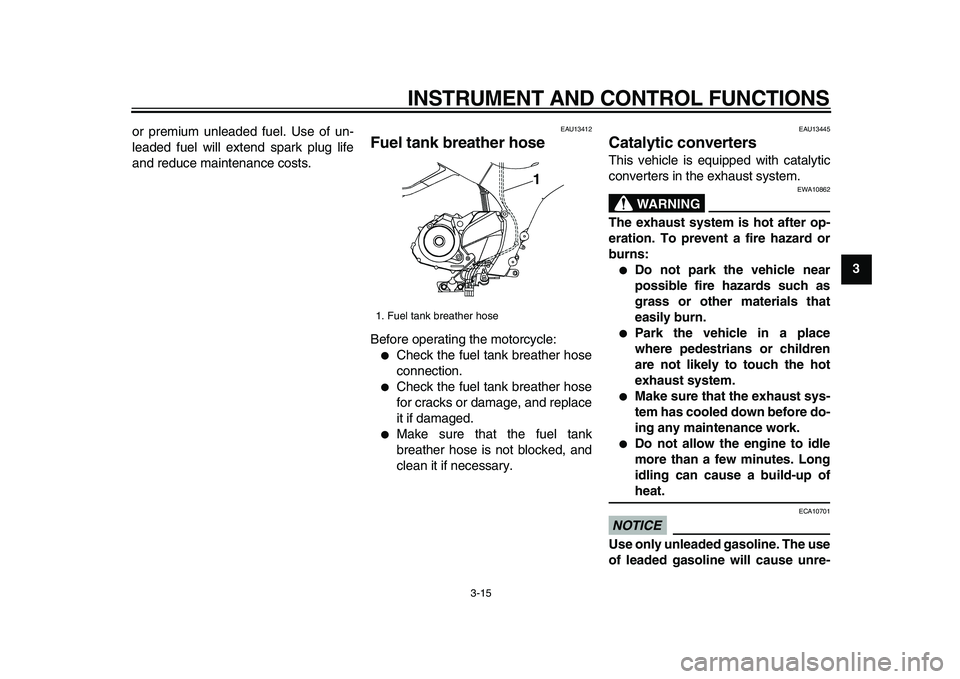
INSTRUMENT AND CONTROL FUNCTIONS
3-15
2
34
5
6
7
8
9
or premium unleaded fuel. Use of un-
leaded fuel will extend spark plug life
and reduce maintenance costs.
EAU13412
Fuel tank breather hose
Before operating the motorcycle:
●
Check the fuel tank breather hose
connection.
●
Check the fuel tank breather hose
for cracks or damage, and replace
it if damaged.
●
Make sure that the fuel tank
breather hose is not blocked, and
clean it if necessary.
EAU13445
Catalytic converters
This vehicle is equipped with catalytic
converters in the exhaust system.
WARNING
EWA10862
The exhaust system is hot after op-
eration. To prevent a fire hazard or
burns:
●
Do not park the vehicle near
possible fire hazards such as
grass or other materials that
easily burn.
●
Park the vehicle in a place
where pedestrians or children
are not likely to touch the hot
exhaust system.
●
Make sure that the exhaust sys-
tem has cooled down before do-
ing any maintenance work.
●
Do not allow the engine to idle
more than a few minutes. Long
idling can cause a build-up of
heat.
NOTICE
ECA10701
Use only unleaded gasoline. The use
of leaded gasoline will cause unre-
1. Fuel tank breather hose
1
Page 37 of 94
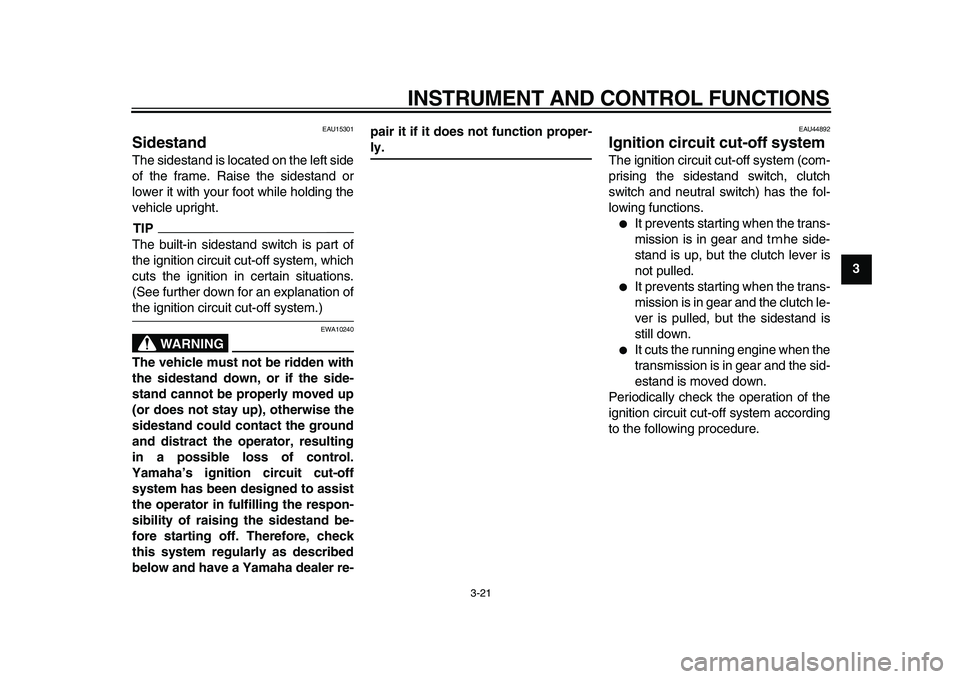
INSTRUMENT AND CONTROL FUNCTIONS
3-21
2
34
5
6
7
8
9
EAU15301
Sidestand
The sidestand is located on the left side
of the frame. Raise the sidestand or
lower it with your foot while holding the
vehicle upright.
TIP
The built-in sidestand switch is part of
the ignition circuit cut-off system, which
cuts the ignition in certain situations.
(See further down for an explanation of
the ignition circuit cut-off system.)
WARNING
EWA10240
The vehicle must not be ridden with
the sidestand down, or if the side-
stand cannot be properly moved up
(or does not stay up), otherwise the
sidestand could contact the ground
and distract the operator, resulting
in a possible loss of control.
Yamaha’s ignition circuit cut-off
system has been designed to assist
the operator in fulfilling the respon-
sibility of raising the sidestand be-
fore starting off. Therefore, check
this system regularly as described
below and have a Yamaha dealer re-pair it if it does not function proper-
ly.
EAU44892
Ignition circuit cut-off system
The ignition circuit cut-off system (com-
prising the sidestand switch, clutch
switch and neutral switch) has the fol-
lowing functions.
●
It prevents starting when the trans-
mission is in gear and t
he side-
stand is up, but the clutch lever is
not pulled.
●
It prevents starting when the trans-
mission is in gear and the clutch le-
ver is pulled, but the sidestand is
still down.
●
It cuts the running engine when the
transmission is in gear and the sid-
estand is moved down.
Periodically check the operation of the
ignition circuit cut-off system according
to the following procedure.
Page 38 of 94
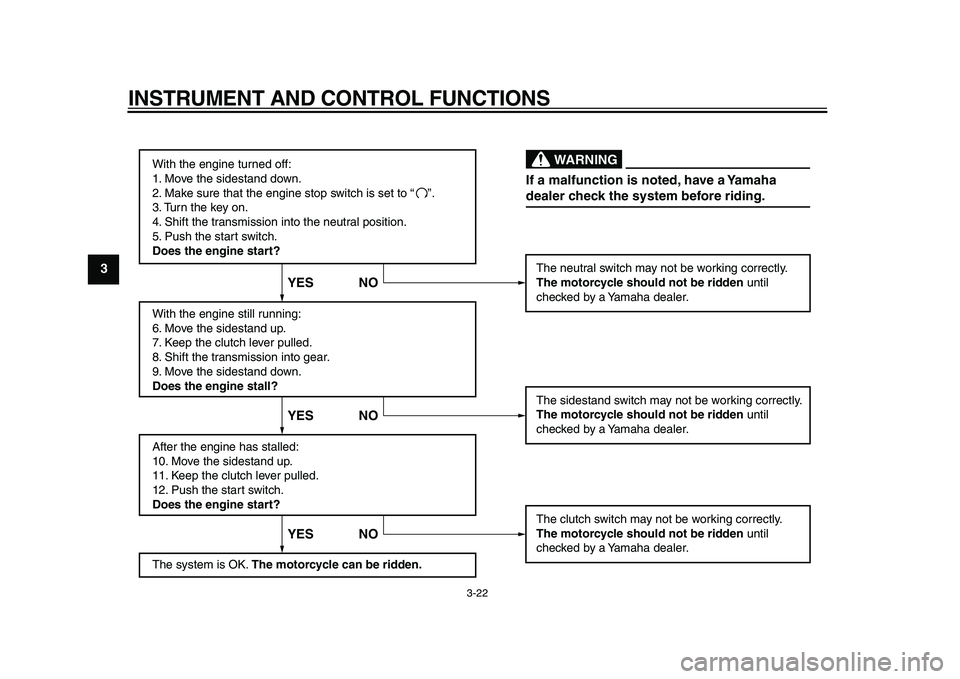
INSTRUMENT AND CONTROL FUNCTIONS
3-22
1
2
3
4
5
6
7
8
9
With the engine turned off:
1. Move the sidestand down.
2. Make sure that the engine stop switch is set to “
3. Turn the key on.
4. Shift the transmission into the neutral position.
5. Push the start switch.
Does the engine start?
With the engine still running:
6. Move the sidestand up.
7. Keep the clutch lever pulled.
8. Shift the transmission into gear.
9. Move the sidestand down.
Does the engine stall?
After the engine has stalled:
10. Move the sidestand up.
11. Keep the clutch lever pulled.
12. Push the start switch.
Does the engine start?
The system is OK. The motorcycle can be ridden.The neutral switch may not be working correctly.
The motorcycle should not be ridden until
checked by a Yamaha dealer.
The sidestand switch may not be working correctly.
The motorcycle should not be ridden until
checked by a Yamaha dealer.
The clutch switch may not be working correctly.
The motorcycle should not be ridden until
checked by a Yamaha dealer.
YES NO YES NO YES NO
If a malfunction is noted, have a Yamaha
dealer check the system before riding.
WARNING
”.
Page 39 of 94
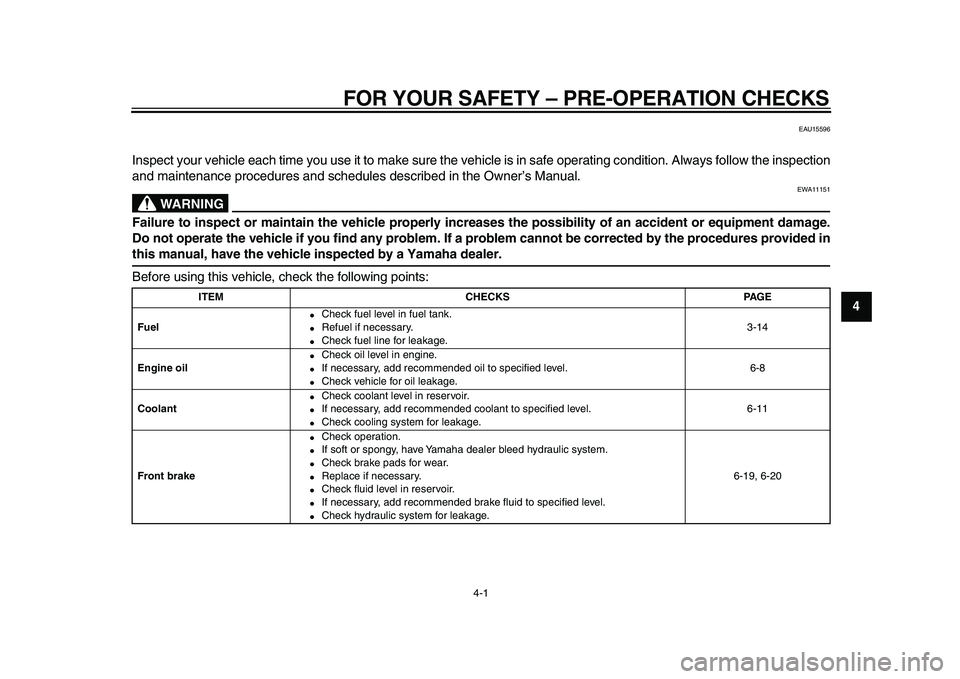
4-1
2
3
45
6
7
8
9
FOR YOUR SAFETY – PRE-OPERATION CHECKS
EAU15596
Inspect your vehicle each time you use it to make sure the vehicle is in safe operating condition. Always follow the inspection
and maintenance procedures and schedules described in the Owner’s Manual.
WARNING
EWA11151
Failure to inspect or maintain the vehicle properly increases the possibility of an accident or equipment damage.
Do not operate the vehicle if you find any problem. If a problem cannot be corrected by the procedures provided in
this manual, have the vehicle inspected by a Yamaha dealer.
Before using this vehicle, check the following points:
ITEM CHECKS PAGE
Fuel
●
Check fuel level in fuel tank.
●
Refuel if necessary.
●
Check fuel line for leakage.3-14
Engine oil
●
Check oil level in engine.
●
If necessary, add recommended oil to specified level.
●
Check vehicle for oil leakage.6-8
Coolant
●
Check coolant level in reservoir.
●
If necessary, add recommended coolant to specified level.
●
Check cooling system for leakage.6-11
Front brake
●
Check operation.
●
If soft or spongy, have Yamaha dealer bleed hydraulic system.
●
Check brake pads for wear.
●
Replace if necessary.
●
Check fluid level in reservoir.
●
If necessary, add recommended brake fluid to specified level.
●
Check hydraulic system for leakage.6-19, 6-20
Page 42 of 94
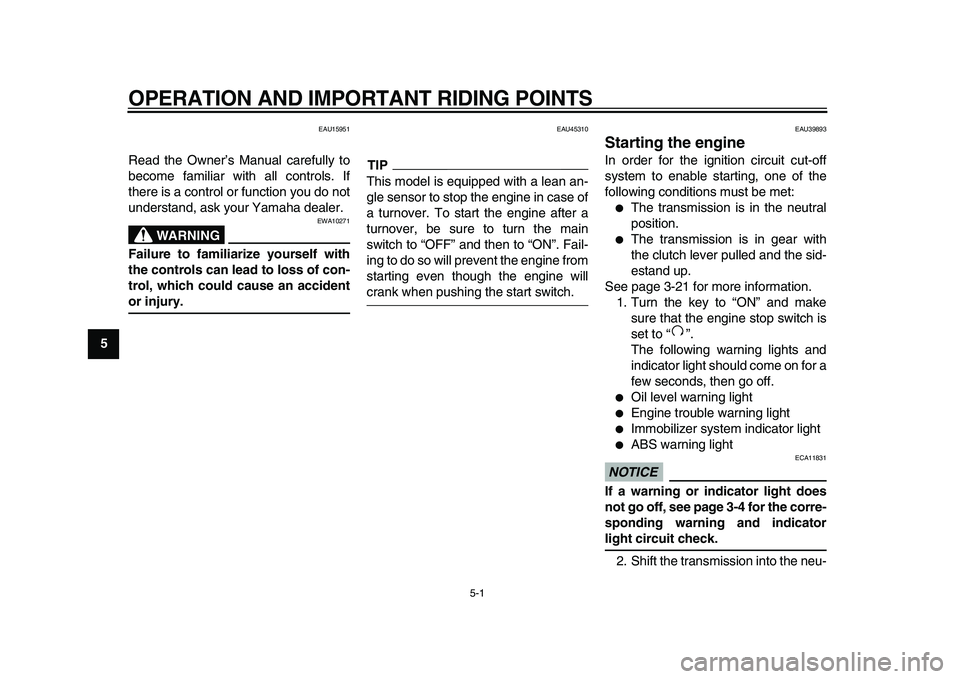
5-1
1
2
3
4
5
6
7
8
9
OPERATION AND IMPORTANT RIDING POINTS
EAU15951
Read the Owner’s Manual carefully to
become familiar with all controls. If
there is a control or function you do not
understand, ask your Yamaha dealer.
WARNING
EWA10271
Failure to familiarize yourself with
the controls can lead to loss of con-
trol, which could cause an accident
or injury.
EAU45310
TIP
This model is equipped with a lean an-
gle sensor to stop the engine in case of
a turnover. To start the engine after a
turnover, be sure to turn the main
switch to “OFF” and then to “ON”. Fail-
ing to do so will prevent the engine from
starting even though the engine will
crank when pushing the start switch.
EAU39893
Starting the engine
In order for the ignition circuit cut-off
system to enable starting, one of the
following conditions must be met:
●
The transmission is in the neutral
position.
●
The transmission is in gear with
the clutch lever pulled and the sid-
estand up.
See page 3-21 for more information.
1. Turn the key to “ON” and make
sure that the engine stop switch is
set to “ ”.
The following warning lights and
indicator light should come on for a
few seconds, then go off.
●
Oil level warning light
●
Engine trouble warning light
●
Immobilizer system indicator light
●
ABS warning light
NOTICE
ECA11831
If a warning or indicator light does
not go off, see page 3-4 for the corre-
sponding warning and indicator
light circuit check.
2. Shift the transmission into the neu-